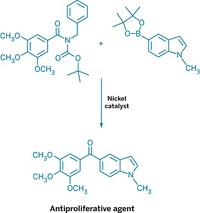Advertisement
Grab your lab coat. Let's get started
Welcome!
Welcome!
Create an account below to get 6 C&EN articles per month, receive newsletters and more - all free.
It seems this is your first time logging in online. Please enter the following information to continue.
As an ACS member you automatically get access to this site. All we need is few more details to create your reading experience.
Not you? Sign in with a different account.
Not you? Sign in with a different account.
ERROR 1
ERROR 1
ERROR 2
ERROR 2
ERROR 2
ERROR 2
ERROR 2
Password and Confirm password must match.
If you have an ACS member number, please enter it here so we can link this account to your membership. (optional)
ERROR 2
ACS values your privacy. By submitting your information, you are gaining access to C&EN and subscribing to our weekly newsletter. We use the information you provide to make your reading experience better, and we will never sell your data to third party members.
Synthesis
Picking Off Hydrogen
Organic Synthesis: Use of palladium catalyst yields aromatic molecules from aliphatic precursors
by Bethany Halford
June 13, 2011
| A version of this story appeared in
Volume 89, Issue 24

Using a palladium catalyst to pluck hydrogen from cyclohexanones and cyclohexenones, chemists have developed an environmentally friendly route to substituted phenols (Science, DOI: 10.1126/science.1204183). Such aromatic molecules are key constituents of pharmaceuticals, electronic materials, and plastics, and the new method offers a simple way to make molecules that might otherwise require significant synthetic machinations.
“Most routes to substituted aromatics involve decorating the periphery of an existing aromatic molecule,” explains University of Wisconsin, Madison, chemistry professor Shannon S. Stahl, who developed the transformation along with coworkers Yusuke Izawa and Doris Pun. Rather than trying to add substituents to an existing aromatic framework, Stahl and coworkers pull hydrogen from nonaromatic starting materials with the desired substitution pattern. The reaction even gives access to meta-substituted phenols, which are tough to make via traditional aromatic substitution reactions because of the directing effects of the phenolic hydroxyl group.
This dehydrogenation strategy for making phenols has been used in the past with cyclohexenones, but that reaction required stoichiometric amounts of undesirable reagents. The new reaction is aerobic, using molecular oxygen as a hydrogen acceptor and producing water as the only by-product.
The key to the reaction is a palladium(II) catalyst that incorporates an unconventional ortho-dimethylaminopyridine ligand. “Most of the known palladium catalysts for aerobic oxidations and C–H oxidations didn’t work, so we came up with this rather unusual ligand,” Stahl says.
“Among the strategically appealing features of Stahl’s phenol synthesis is that it marries traditional methods for the construction of substituted cyclohexanones and cyclohexenones with the rapidly advancing field of Pd-catalyzed aerobic oxidations,” comments Robert E. Maleczka Jr., a professor at Michigan State University who studies synthetic methodology and the synthesis of pharmaceutically relevant compounds. “The community will be very interested in seeing the full substrate scope of the reaction and especially the ability of the catalytic system to oxidize substrates bearing nitrogen and other basic moieties,” he says.





Join the conversation
Contact the reporter
Submit a Letter to the Editor for publication
Engage with us on Twitter